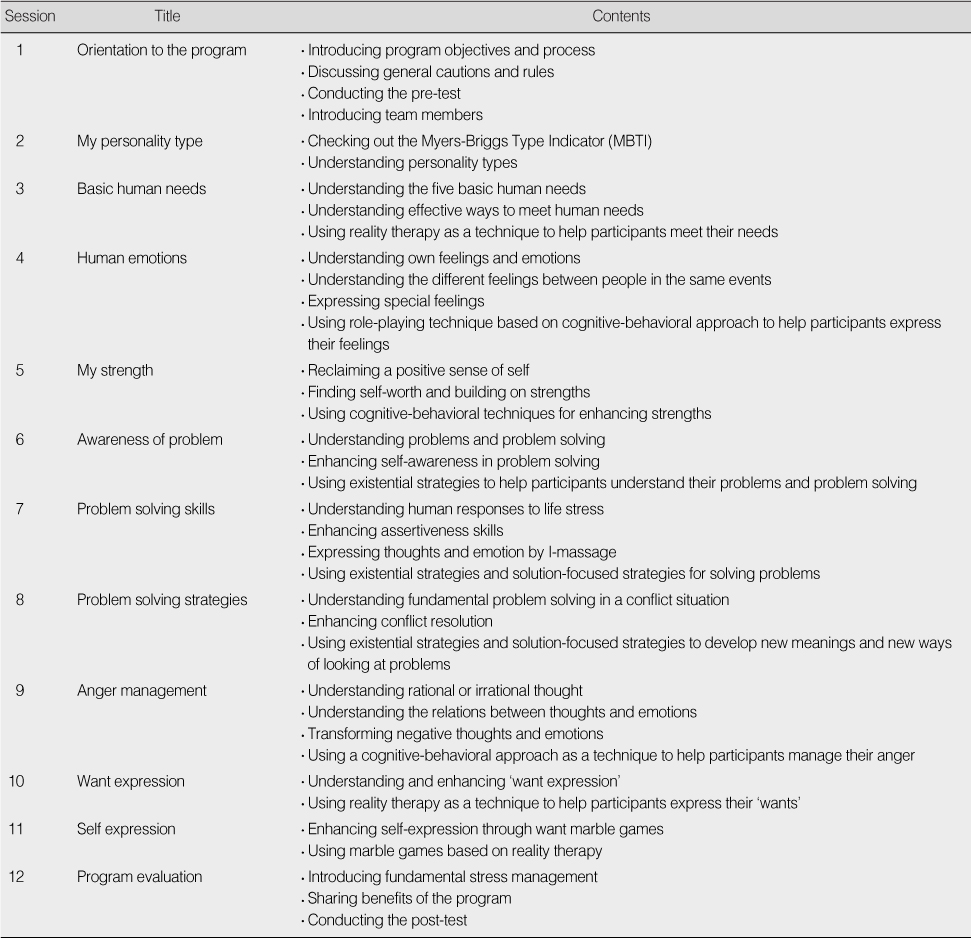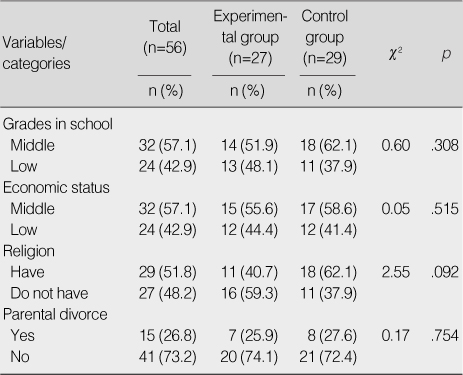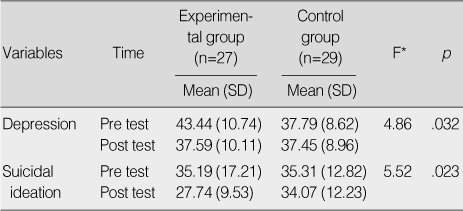Articles
- Page Path
- HOME > J Korean Acad Nurs > Volume 39(6); 2009 > Article
-
Original Article
- Effects of Core Competency Support Program on Depression and Suicidal Ideation for Adolescents
- Hyun Sook Park
-
Journal of Korean Academy of Nursing 2009;39(6):851-859.
DOI: https://doi.org/10.4040/jkan.2009.39.6.851
Published online: December 31, 2009
Professor, College of Nursing, Catholic University of Daegu, Daegu, Korea.
- Address reprint requests to: Park, Hyun Sook. College of Nursing, Catholic University of Daegu, 3056-6 Daemyeong 4-dong, Nam-gu, Daegu 705-718, Korea. Tel: 82-53-650-4827, Fax: 82-53-621-4106, parkhs@cu.ac.kr
• Received: May 7, 2009 • Accepted: November 20, 2009
Copyright © 2009 Korean Society of Nursing Science
Abstract
-
Purpose
- The purpose of this study was to evaluate the effects of a core competency support program on depression and suicidal ideation in adolescents.
-
Methods
- A quasi-experimental design was employed in this study. Participants for the study were high school students, 27 in the experimental group and 29 in the control group. Data were analyzed using the SPSS/WIN. 14.0 program with χ2 test, t-test, and ANCOVA.
-
Results
- Participants in the core competency support program reported decreased depression scores significantly different from those in the control group. Participants in the core competency support program reported decreased suicidal ideation scores, also significantly different from those in the control group.
-
Conclusion
- The core competency support program was effective in decreasing depression and suicidal ideation for adolescents. Therefore, this approach is recommended as a suicide prevention strategy for adolescents.
This work was supported by the Korean Research Foundation Grant by Korean Government (MOEHRD) (KRF-2007-313-E00579).
- 1. Beautrais AL. Gender issues in youth suicidal behavior. Emergency Medicine. 2002;14:35–42.ArticlePubMed
- 2. Borenstein M, Rothstein H, Cohen J. Power and precision: A computer program for statistical power analysis confidence interval. 2001;Englewood, NJ, Boostat.
- 3. Bradshaw CP, O'Brennan LM, McNeely CA. Core competencies and the prevention of school failure and early school leaving. In N. G. Guerra & C. P. Bradshaw (Eds.), Core competencies to prevent problem behaviors and promote positive youth development. New Direction for Child and Adolescent Development. 2008;122:19–32.
- 4. Byun KY. Development of the group program on empowerment for victim students of school bullying and its effectiveness. Studies on Korean Youth. 2006;17:263–295.
- 5. Choi JS. A meta analysis of the effects of group counseling on self-esteem. 2004;Cheongwon, Korea National University of Education. –Unpublished master's thesis.
- 6. Chon KK, Lee MK. Preliminary development of Korean version of CES-D. Korean Journal of Clinical Psychology. 1992;11:65–76.
- 7. Evans E, Hawton K, Rodham K. Factors associated with suicidal phenomena in adolescents: A systematic review of population-based studies. Clinical Psychology Review. 2004;24:957–979.ArticlePubMed
- 8. Frye AA, Goodman SH. Which social problem-solving components buffer depression in adolescent girls? Cognitive Therapy and Research. 2000;24:637–650.ArticlePDF
- 9. Goldney RD, Fisher LJ, Cheok F. Mental health literacy of those with major depression and suicidal ideation: An impediment to help seeking. Suicide and Life-Threatening Behavior. 2002;32:394–404.ArticlePubMedPDF
- 10. Guerra NG, Bradshaw CP. Linking the prevention of problem behaviors and positive youth development: Core competencies for positive youth development and risk prevention. New Direction for Child and Adolescent Development. 2008;122:1–17.
- 11. Haegerich TM, Tolan PH. In N. G. Guerra & C. P. Bradshaw (Eds.), Core competencies to prevent problem behaviors and promote positive youth development. New Direction for Child and Adolescent Development. 2008;122:47–60.
- 12. Jo CB, Song AY, Lee SH. Study for violence between parents exposure and internet addiction of adolescents: Mediating effect of depression and moderating effect of problemsolving. Korean Journal of Social Welfare Research. 2007;16:73–103.
- 13. Korea National Statistical Office. Annual report on the causes of death statistics in 2007. 2008;Daejeon, Author.
- 14. Lee CS, Kweon YR, Kim SJ, Choi BS. The effect of suicidal prevention program on depression, suicidal ideation, and problem ability on middle school students. Journal of KoreanAcademy of Psychiatric and Mental Health Nursing. 2007;16:337–347.
- 15. Lee EH, Choi TS, Seo MJ. Effects of stress related to school, self-esteem, parent-children communication, and parents' internal support of adolescent depression. The Korean Journal of Counseling and Psychotherapy. 2000;12(2):69–84.
- 16. Lee HJ, Lee YJ. An impact of adolescent' perception of mother-adolescent communication on self-esteem and depression. The Korean Journal of Counseling. 2005;6:197–209.
- 17. Lee SJ. A study on the development of life-skills: Communication, problem solving, and learning. 2003;Seoul, Korean Educational Development Institute.
- 18. Matsuishi K, Kitamura N, Sato M, Nagai K, Huh SY, Ariyoshi K, et al. Change of suicidal ideation induced bysuicidal attempt. Psychiatry and Clinical Neurosciences. 2005;59:599–604.PubMed
- 19. Oh HA, Park YR, Choi MH. The effects of parent-adolescent communication and depression on suicidal ideation. Journal of Korean Academy of Child Health Nursing. 2008;14:35–43.
- 20. Park BK. Factors associated with adolescents' suicidal ideation: Focus on self-esteem and depression as mediators. Journal of Korean Living Science Association. 2007;16:505–522.Article
- 21. Park HS. Validation of path model on adolescents' suicidal ideation and violent behavior. Journal of Korean Academy of Nursing. 2007;37:835–843.PubMed
- 22. Park HS. The development of an integrated suicide·violence prevention program for adolescents. Journal of Korean Academy of Nursing. 2008;38:513–521.ArticlePubMed
- 23. Park HS, Koo HY. The buffering effect of parent-adolescent communication in the relation between stress and suicidal ideation for Korean adolescents. Journal of Korean Academy of Psychiatric and Mental Health Nursing. 2009;18:87–94.ArticlePDF
- 24. Radloff L. The CES-D scale: A new self-report depression scale for research in the general population. Applied Psychological Measurement. 1977;1:385–401.ArticlePDF
- 25. Reynolds WM. Suicidal ideation questionnaire: Professional manual. 1987;Odessa, FL, Psychological Assessment Resources.
- 26. Seligman M, Steen T, Park N, Peterson C. Positive psychology progress: Empirical validation of interventions. American Psychology. 2005;60:410–421.Article
- 27. Shin MS. An empirical study of the mechanism of suicide: Validation of the scale for escape from the self. 1992;Seoul, Yonsei University. Unpublished doctoral dissertation.
- 28. Simnton DK, Baumeister RF. Positive psychology at the summit. Psychological Review. 2005;9:99–103.ArticlePDF
- 29. Spencer L, Spencer S. Competence at work: Models for superior performance. 1993;New York, NY, John Wiley & Sons.
- 30. You SM, Lee SY. Relationship of perceived stress, maladaptive perfectionism, and suicidal ideation: Focusing on the moderating effects of social problem solving and attachment styles. The Korean Journal of School Psychology. 2008;5:119–136.
REFERENCES
Figure & Data
REFERENCES
Citations
Citations to this article as recorded by 

- Development and Evaluation of a Self-Empowerment Intervention Program for Inpatient at High Risk of Suicide
Hee-Yeon Kim, Kuem-Sun Han
Stress.2019; 27(3): 240. CrossRef - A review of school-based suicide prevention interventions in South Korea, 1995–2015
Jung Won Kong, Jung Woo Kim
Children and Youth Services Review.2016; 69: 193. CrossRef - Analysis of Individual, Social, and Environmental Factors influencing Korean Adolescents’ Depression and Suicidal Ideation by Gender
Yunjeong Yi, Eunyoung Pyo, Jinok Jeong, Jiyeon An
Journal of the Korean Society of School Health.2016; 29(3): 189. CrossRef - Associations of physical activity by intensity (moderate vs. vigorous) with depression and suicidal thoughts among middle school students in South Korea
Ji-Yeon An
Journal of the Korea Academia-Industrial cooperation Society.2014; 15(12): 7266. CrossRef - Factors Influencing Suicidal Ideation in People with Mental Disorder
Seong Yee Seo, Hee Sook Kim, Yang Tae Kim
Journal of Korean Academy of Community Health Nursing.2013; 24(2): 245. CrossRef - Effects of Competency Model Based Education Program on Risk Behavior and Competences for Preventing Adolescents' Risk Behavior for Adolescents
Hyun Sook Park, Sun Young Jung, Eun Jin Kim
Journal of the Korea Academia-Industrial cooperation Society.2013; 14(4): 1799. CrossRef - The Protective Factors of Suicide Probability in Religious Male High School Students
Hee Sook Kim, Young Sun Chae, Young Joo Bae
Journal of Korean Academy of Nursing.2012; 42(1): 1. CrossRef
Effects of Core Competency Support Program on Depression and Suicidal Ideation for Adolescents
Effects of Core Competency Support Program on Depression and Suicidal Ideation for Adolescents
Outlines of Core Competency Support Program
General Characteristics and Homogeneity between the Two Groups (N=56)
Homogeneity of Dependent Variables between the Two Groups at Pretest (N=56)
Comparison of Depression and Suicidal Ideation between the Two Groups (N=56)
*F-value of ANCOVA with pre-test value as covariate.
Table 1
Outlines of Core Competency Support Program
Table 2
General Characteristics and Homogeneity between the Two Groups (N=56)
Table 3
Homogeneity of Dependent Variables between the Two Groups at Pretest (N=56)
Table 4
Comparison of Depression and Suicidal Ideation between the Two Groups (N=56)
*F-value of ANCOVA with pre-test value as covariate.
 KSNS
KSNS
 E-SUBMISSION
E-SUBMISSION




 Cite
Cite

